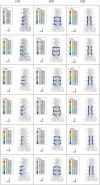Biomechanical Analysis of Double-Level Oblique Lumbar Fusion with Different Types of Fixation: A Finite Element-Based Study
- PMID: 37073100
- PMCID: PMC10157704
- DOI: 10.1111/os.13703
Biomechanical Analysis of Double-Level Oblique Lumbar Fusion with Different Types of Fixation: A Finite Element-Based Study
Abstract
Objective: One well-liked less invasive procedure is oblique lumbar interbody fusion (OLIF). The biomechanical characteristics of double-level oblique lumbar interbody fusion in conjunction with various internal fixations are poorly understood. The purpose of this study was to clarify the biomechanical characteristics of double-level oblique lumbar interbody fusion for osteoporosis spines using various internal fixation techniques.
Methods: Based on CT scans of healthy male volunteers, a complete finite element model of osteoporosis in L1-S1 was established. After validation, L3-L5 was selected as the surgical segment to construct four surgical models: (a) two stand-alone cages (SA); (b) two cages with unilateral pedicle screws (UPS); (c) two cages with bilateral pedicle screws (BPS); and (d) two cages with bilateral cortical bone trajectory screws (CBT). Segmental range of motion (ROM), cage stress, and internal fixation stress were studied in all surgical models and compared with the intact osteoporosis model.
Results: The SA model had a minimal reduction in all motions. The CBT model had the most noticeable reduction in flexion and extension activities, while the reduction in the BPS model was slightly less than that in the CBT model but larger than that in the UPS model. The BPS model had the greatest limitation in left-right bending and rotation, which was greater than the UPS and CBT models. CBT had the smallest limitation in left-right rotation. The cage stress of the SA model was the highest. The cage stress in the BPS model was the lowest. Compared with the UPS model, the cage stress in the CBT model was larger in terms of flexion and LB and LR but slightly smaller in terms of RB and RR. In the extension, the cage stress in the CBT model is significantly smaller than in the UPS model. The CBT internal fixation was subjected to the highest stress of all motions. The BPS group had the lowest internal fixation stress in all motions.
Conclusions: Supplemental internal fixation can improve segmental stability and lessen cage stress in double-level OLIF surgery. In limiting segmental mobility and lowering the stress of cage and internal fixation, BPS outperformed UPS and CBT.
Keywords: Biomechanical; Cortical Bone Trajectory Screw; Finite Element Analysis; Oblique Lumbar Interbody Fusion; Osteoporosis; Posterior Pedicle Screw.
© 2023 The Authors. Orthopaedic Surgery published by Tianjin Hospital and John Wiley & Sons Australia, Ltd.
Conflict of interest statement
The authors declare no conflict of interest.
Figures







Similar articles
-
Oblique lateral interbody fusion combined with different internal fixations for the treatment of degenerative lumbar spine disease: a finite element analysis.BMC Musculoskelet Disord. 2022 Mar 4;23(1):206. doi: 10.1186/s12891-022-05150-x. BMC Musculoskelet Disord. 2022. PMID: 35246101 Free PMC article.
-
Biomechanical changes of oblique lumbar interbody fusion with different fixation techniques in degenerative spondylolisthesis lumbar spine: a finite element analysis.BMC Musculoskelet Disord. 2024 Aug 24;25(1):664. doi: 10.1186/s12891-024-07796-1. BMC Musculoskelet Disord. 2024. PMID: 39182026 Free PMC article.
-
Biomechanical Evaluation of Oblique Lumbar Interbody Fusion with Various Fixation Options: A Finite Element Analysis.Orthop Surg. 2021 Apr;13(2):517-529. doi: 10.1111/os.12877. Epub 2021 Feb 22. Orthop Surg. 2021. PMID: 33619850 Free PMC article.
-
Finite element analysis of biomechanical investigation on diverse internal fixation techniques in oblique lumbar interbody fusion.BMC Musculoskelet Disord. 2024 Oct 12;25(1):804. doi: 10.1186/s12891-024-07887-z. BMC Musculoskelet Disord. 2024. PMID: 39395967 Free PMC article.
-
Complete Intradural Interbody Cage Migration in Lumbar Spine Surgery: A Case Report and Literature Review.Medicina (Kaunas). 2023 May 16;59(5):956. doi: 10.3390/medicina59050956. Medicina (Kaunas). 2023. PMID: 37241188 Free PMC article. Review.
Cited by
-
Lateral Fusion is a Unique Feature in Oblique Lumbar Interbody Fusion Surgery: A Retrospective Cohort Study.Global Spine J. 2025 Jun;15(5):2714-2725. doi: 10.1177/21925682241310151. Epub 2024 Dec 17. Global Spine J. 2025. PMID: 39690925 Free PMC article.
-
Clinical evaluation and finite element analysis of bone cement-augmented anterolateral screw fixation versus percutaneous bilateral pedicle screw fixation co-applied with oblique lumbar interbody fusion for single-level lumbar degenerative diseases with osteoporosis.Front Bioeng Biotechnol. 2025 Jun 10;13:1571849. doi: 10.3389/fbioe.2025.1571849. eCollection 2025. Front Bioeng Biotechnol. 2025. PMID: 40557307 Free PMC article.
-
Biomechanical properties analysis of posterior lumbar interbody fusion with transpedicular oblique screw fixation.Heliyon. 2024 Oct 4;10(19):e38929. doi: 10.1016/j.heliyon.2024.e38929. eCollection 2024 Oct 15. Heliyon. 2024. PMID: 39435082 Free PMC article.
-
Biomechanical impact of cortical bone vs. traditional pedicle screw trajectories: a finite element study on lumbar spinal instrumentation.Front Bioeng Biotechnol. 2025 Feb 18;13:1541114. doi: 10.3389/fbioe.2025.1541114. eCollection 2025. Front Bioeng Biotechnol. 2025. PMID: 40041103 Free PMC article.
-
Biomechanical evaluation of oblique lateral interbody fusion with various fixation methods for degenerative lumbar scoliosis: a finite element analysis considering different bone densities.Front Bioeng Biotechnol. 2025 May 8;13:1562268. doi: 10.3389/fbioe.2025.1562268. eCollection 2025. Front Bioeng Biotechnol. 2025. PMID: 40406587 Free PMC article.
References
-
- Abe K, Orita S, Mannoji C, et al. Perioperative complications in 155 patients who underwent oblique lateral interbody fusion surgery: perspectives and indications from a retrospective, multicenter survey. Spine. 2017;42(1):55–62. - PubMed
-
- Li JX, Phan K, Mobbs R. Oblique lumbar interbody fusion: technical aspects, operative outcomes, and complications. World Neurosurg. 2017;98:113–23. - PubMed
-
- Woods KR, Billys JB, Hynes RA. Technical description of oblique lateral interbody fusion at L1‐L5 (OLIF25) and at L5‐S1 (OLIF51) and evaluation of complication and fusion rates. Spine J. 2017;17:545–53. - PubMed
-
- Chung NS, Lee HD, Jeon CH. Accuracy of the lateral cage placement under intraoperative C‐arm fluoroscopy in oblique lateral interbody fusion. J Orthop Sci. 2018;23:918–22. - PubMed
MeSH terms
Grants and funding
LinkOut - more resources
Full Text Sources
Medical

